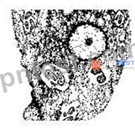ASCP ASCP-MLT試験情報と無料練習テストはこちら
合格させるASCP ASCP-MLTプレミアムお試しセットテストエンジンPDFで無料問題集セット
質問 216
Entamoeba gingivalis resembles Entamoeba histolytica both in size and in nuclear characteristics. Entamoeba gingivalis may contain numerous cytoplasmic inclusions such as red blood cells, white blood cells, and bacteria.
I reside in the mouth where I measure approximately 17 micro meters.
- A. Acanthamoeba species trophozoite
- B. Trichomonas vaginalis trophozoite
- C. Entamoeba coli trophozoite
- D. Entamoeba gingivalis trophozoite
正解: D
質問 217
Laboratories performing which of the following types of tests need to be enrolled in a CLIA-approved proficiency testing program?
- A. both moderately and highly complex
- B. Moderately complex
- C. Waived
- D. Highly complex
正解: A
質問 218
What are the certification requirements for clinical laboratory professionals?
- A. college degree and a national certification exam
- B. college degree
- C. on the job training
- D. national certification exam
正解: A
質問 219
The risk of HbS polymerization is enhanced by a low (acid) pH, a state of dehydration, and increased levels of
2,3-DPG. Increased temperature (above 37°C) also adds to the risk.
Hematology
Which group of conditions INCREASES the risk of HbS polymerization?
- A. Alkaline pH,dehydration, decreased level of 2,3-DPG
- B. Alkaline pH, dehydration, increased level of 2,3-DPG
- C. Acid pH, dehydration, decreased level of 2,3-DPG
- D. Acid pH,dehydration, increased level of 2,3-DPG
正解: D
質問 220
1+ reaction has numerous small clumps and cloudy red supernatant
2+ has many medium-sized clumps and clear supernatant.
3+ has several large clumps and clear supernatant
4+ has one solid clump, no free cells, and clear supernatant
BB
Tube-based agglutination reactions in blood bank are graded from negative (0) to 4+. A reaction that has numerous small clumps in a cloudy, red background is:
- A. 2+
- B. 4+
- C. 1+
- D. 3+
正解: C
質問 221
A dilution commonly used for a routine sperm count is a 1:20.
A dilution commonly used for a routine sperm count is:
- A. 1:400
- B. 1:2
- C. 1:20
- D. 1:200
正解: C
質問 222
Which of the following hormones stimulates gluconeogenesis, the formation of glucose from noncarbohydrate sources such as amino acids, glycerol, and fatty acids?
- A. Cortisol
- B. Insulin
- C. Epinephrine
正解: A
質問 223
The intended response is "transfusion dimorphism". The microcytic, hypochromic erythrocytes suggests iron deficiency anemia. Interspersed among these cells are normocytic, normochromic erythrocytes suggesting two populations of red cells following transfusion. This was a case of severe iron deficiency treated with red cell transfusions and iron supplement.
The condition most likely associated with the peripheral blood picture in the photograph is:
- A. Hereditary spherocytosis
- B. Folic acid deficiency
- C. Lead poisoning
- D. Transfusion dimorphism
正解: D
質問 224
Kell, Kidd, and Duffy are usually warm reacting IgG antibodies. The most common P system antibody is anti-P1, which is a frequently naturally occurring low titer IgM antibody, seen in most P2 individuals.
Blood bank
Which of the following blood groups is most frequently associated with cold agglutinins:
- A. Kidd
- B. Kell
- C. P
- D. Duffy
正解: C
質問 225
Small, dense LDL is most likely to interact with arterial walls, leading to deposition of cholesterol, and initiating or worsening atherosclerosis. Small, dense LDL is associated with more than a three-fold increase in the risk of coronary heart disease.
Large, buoyant LDL is less atherogenic than small, dense LDL.
The LDL phenotype A is normal. It is the so called 'B' pattern that is associated with increased risk.
Which of the following is most likely to interact with arterial walls, leading to deposition of cholesterol, and initiating or worsening atherosclerosis?
- A. LDL phenotype 'A'
- B. Large buoyant LDL
- C. Small dense LDL
正解: C
質問 226
Provide the equivalent measurement for one gallon.
Question options:
- A. 4.2 liters
- B. 3.79 liters
- C. 1 liter
- D. 2.5 liters
正解: B
質問 227
One of the following may cause a laboratory acquired infection (LAI):
- A. Needlestick exposure
- B. Cut on the employee's hand that is not covered
- C. Applying chapstick in the laboratory
- D. All of the above
正解: D
質問 228
These are tyrosine crystals
Urinalysis & Other Body Fluids
True or false? Cystine crystals are present on this slide.
- A. False
- B. True
正解: B
質問 229
The normal pH of blood is 7.40. In order for most metabolic processes to take place, the pH must remain within a narrow range close to this value. The range is usually defined in adults as 7.35-7.45. If blood pH falls below 7.35, the blood becomes too acidic (acidosis). If blood rises above 7.45, the blood is too alkaline (alkalosis).
As blood pH decreases, the kidneys will retain bicarbonate (HCO3-) from the glomerular filtrate; therefore, bicarbonate is increased. However, in this case, the increased HCO3- could not compensate for the markedly elevated pCO2 (the respiratory component) and the condition that results is uncompensated respiratory acidosis.
What condition is indicated by the following blood gas results: Bicarbonate = 32 mmol/L (Normal = 22 - 26 mmol/L); pCO2 = 65 mm Hg (Normal = 35 - 45 mmHg); pH = 7.28 (normal = 7.35 - 7.45)
- A. Healthy condition
- B. Uncompensated metabolic acidosis
- C. Uncompensated respiratory acidosis
- D. Compensated metabolic acidosis
正解: B
質問 230
The correct set of patient data would be: Hgb A = 60%, Hgb S = 38%, Hgb A2 = 2%, Hgb F = 0% Patients with sickle cell trait commonly have Hgb A values between 40 and 60%, Hgb S values between 20 and 40% and Hgb A2 values between 2 and 3%.
A known sickle cell trait patient has a hemoglobin electrophoresis test performed. Which of the following hemoglobin percentage sets would most closely match this patient's diagnostic state?
- A. Hgb A = 40%, Hgb S = 58%, Hgb A2 = 2%, Hgb F = 0%
- B. Hgb A = 90%, Hgb S = 8%, Hgb A2 = 2%, Hgb F = 0%
- C. Hgb A = 25%, Hgb S = 70%, Hgb A2 = 2%, Hgb F = 3%
- D. Hgb A = 60%, Hgb S = 38%, Hgb A2 = 2%, Hgb F = 0%
正解: D
質問 231
Whole blood glucose values are lower than plasma glucose values. For this reason, point-of-care whole blood glucose meters are programmed to correct the value before presenting the result; therefore, the whole blood glucose meter result correlates to serum or plasma results.
Whole blood glucose values are ____________ plasma glucose values.
- A. Greater than
- B. Equal to
- C. Lower than
正解: C
質問 232
Cerebrospinal fluid has three main functions:
Protect brain and spinal cord from trauma.
Supply nutrients to nervous system tissue.
Remove waste products from cerebral metabolism.
Which of the following are functions of CSF? Please select all correct answers
- A. Protect spinal cord from injury.
- B. Regulate body metabolism.
- C. Supply nutrients to nervous system tissue.
- D. Remove waste products from cerebral metabolism.
正解: A,C,D
質問 233
Rapid vascular constriction, not dilation, immediately occurs when there is vascular injury in order to constrict the amount of blood that escapes the vessels; ultimately preventing massive loss of blood.
Primary hemostatic processes resulting from vascular damage include all of the following EXCEPT:
- A. platelet granule release and fibrinogen mediate platelet aggregation
- B. b & c
- C. von Willebrand factor mediates platelet adhesion
- D. collagen activates glycoprotein IIb/IIIa during platelet activation
- E. rapid and immediate vascular dilation occurs
正解: E
質問 234
Convert the following temperature from Celsius to Fahrenheit
-4 degrees C
- A. 24.8 degrees F
- B. 27 degrees F
- C. 14 degrees F
- D. 39.2 degrees F
正解: A
質問 235
Calculation:
Cells Counted (in this case the average of both sides) X dilution factor (in this case 100) / # of squares counted (in this case 9) X area of each square (1mm2) X 0.1mm (depth factor) So, in this problem:
158 x 100 / 9 x 1 x 0.1mm = 17555.55/mm3 (can be converted to 17.5 x 109/L*)
*There are 1,000,000 mm3 in a liter (L). So 17555.55 X 1,000,000 = 17.5 x 109/L A manual white blood cell count was performed by the hematology technologist. The cell counts for both sides were 152 and 164 respectively. All nine large squares were counted on each side. The dilution for this kit was pre-measured at 1:100. What should the technologist report as the white cell count?
- A. 17.5 x 10^9/L
- B. 177.5 x 10^9/L
- C. 175 x 10^9/L
- D. 1.75 x 10^9/L
正解: A
質問 236
Microbiology
Matching: The detection of a distinct odor is often helpful in the presumptive identification of bacterial culture isolates. Match each of the odors listed with its corresponding bacterial species name.
1. Streptococcus anginosus (milleri)
2. Pseudomonas aeruginosa
3. Eikenella corrodens
4. Alcaligenes faecalis
- A. Grapes
- B. Pared apples
- C. Butterscotch
- D. Bleach
正解: A,B,C,D
質問 237
......
更新された公式認定はASCP-MLT認証済みのASCP-MLT問題集でPDF:https://www.jpntest.com/shiken/ASCP-MLT-mondaishu
